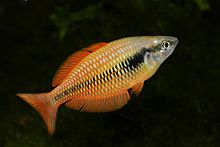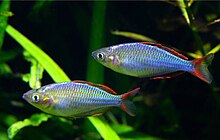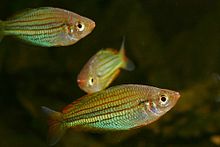Melanotaenia
| Melanotaenia | ||||||||||||
|---|---|---|---|---|---|---|---|---|---|---|---|---|

Melanotaenia fluviatilis from the Murray River |
||||||||||||
| Systematics | ||||||||||||
|
||||||||||||
| Scientific name | ||||||||||||
| Melanotaenia | ||||||||||||
| Gill , 1862 |
Melanotaenia is the most species-rich genus of the rainbow fish (Melanotaeniidae)found in Australia, New Guinea and some neighboring smaller islands. About two thirds of all rainbow fish species belong to it. The genus name refers to a black longitudinal stripe on the body sides of the type species , the black-banded rainbow fish ( Melanotaenia nigrans ). "Melanos" (μελανός) means black in Greek , "taenia" comes from Latin and means stripe.
features
Melanotaenia species are 5.5 to 13 cm long and have a strongly flattened body. The genus is not monophyletic and extremely variable. The type species Melanotaenia nigrans reaches medium size for a rainbow fish and remains relatively slim even with age, like some other species (e.g. M. duboulayi and M. fluviatilis ). Many of the larger species, however, become very high back with age. Even among the smaller species that remain there are high-backed (e.g. M. pygmaea ) and slender forms (e.g. Melanotaenia exquisita , Melanotaenia gracilis and Melanotaenia maccullochi ). Some species are inconspicuously colored (e.g. M. eachamensis ), others are more colorful (e.g. M. boesemani , M. parkinsoni and M. trifasciata ). The difference between the sexes is difficult to discern in some species, but clearly pronounced in others. In these cases, the males are often much more colorful, higher back and have pointed fins.
The mouth is terminal, but the lower jaw can protrude slightly. In contrast to the closely related genus Chilatherina , the premaxillary has a clear kink, in contrast to the genus Glossolepis , in which the rear edge of the scale is sawn, the scales of Melanotaenia are smooth behind.
- Fin formula : dorsal 1 IV – VIII, dorsal 2 I / 7–28, anal I / 14–28.
Systematics
The genus Melanotaenia is not monophyletic . The cladogram below shows the relationships between the species groups and with the genera Chilatherina and Glossolepis .
|
|
|
||||||||||||
|
|
The Australian ichthyologists and rainbow fish experts Gerald Allen and Peter Unmack divide the genus into three geographical groups based on morphological and genetic comparisons. The Melanotaenia species from the Vogelkopf Peninsula form one group, the Australian and southern New Guinea fish and the fish from northern New Guinea form another. New Guinea is divided by a central mountain range consisting of the Maoke Mountains in the Indonesian province of Papua and the Bismarck Mountains in Papua New Guinea . The geographical isolation leads to allopatric speciation .
Many species of rainbow fish are based on long ago, sometimes multiple, natural hybridizations with subsequent backcrossing of different species ( introgression ). For example, the mitochondrial DNA ( mtDNA ) from M. maccullochi has been replaced by the mtDNA from M. splendida in the past ; this in turn had previously been replaced by that of an ancestor of M. maccullochi . Even today there are occasional natural crosses of the species.
species
There are over 80 species of Melanotaenia described , more than half of which are found in the Indonesian western part of New Guinea.
The species listed in the genus Melanotaenia are in detail according to their relationship and geographic grouping:
Western line
Melanotaenia species from Vogelkop , the Bomberai Peninsula and the offshore islands
- Melanotaenia mairasi Allen & Hadiaty , 2011; occurs at the interface between the distribution areas of the species of the western and southern clades. The ancestor of this species is the earliest known split in the family tree within the genus Melanotaenia .
- Waigeo group
- Waigeo rainbow fish ( Melanotaenia catherinae ( de Beaufort , 1910))
- Melanotaenia synergos Allen & Unmack 2008
- Northern Vogelkop Group
- Ajamaru rainbow fish ( Melanotaenia ajamaruensis Allen & Cross , 1980)
- Arfak rainbow fish ( Melanotaenia arfakensis Allen , 1990)
- Melanotaenia batanta Allen & Renyaan , 1998
- Harlequin rainbow fish ( Melanotaenia boesemani Allen & Cross , 1980)
- Melanotaenia ericrobertsi Allen et al., 2014
- Melanotaenia fasinensis Kadarusman , Paradis & Pouyaud , 2010
- Melanotaenia flavipinnis ( Allen et al., 2014)
- Frederick's rainbow fish ( Melanotaenia fredericki ( Fowler , 1939))
- Irianjaya rainbow fish ( Melanotaenia irianjaya Allen , 1985)
- Melanotaenia klasioensis Kadarusman , Hadiaty & Pouyaud , 2015
- Melanotaenia longispina Kadarusman , Avarre & Pouyaud , 2015
- Melanotaenia manibuii Kadarusman , Slembrouck & Pouyaud , 2015
- Misool rainbow fish ( Melanotaenia misoolensis Allen , 1982)
- Melanotaenia multiradiata Allen et al., 2014
- Melanotaenia sembrae Kadarusman , Carman & Pouyaud , 2015
- Melanotaenia salawati Kadarusman, Sudarto, Slembrouck & Pouyaud , 2011
- Melanotaenia susii Kadarusman , Hubert & Pouyaud , 2015
- Southern Vogelkop Group
- Melanotaenia ammeri Allen , Unmack & Hadiaty , 2008
- Melanotaenia arguni Kadarusman , Hadiaty , Segura , Setiawibawa , Caruso , Pouyaud , 2012
- Angfa rainbow fish ( Melanotaenia angfa Allen , 1990)
- Melanotaenia kokasensis Allen , Unmack & Hadiaty , 2008
- Melanotaenia laticlavia Allen et al., 2014
- Melanotaenia naramasae Kadarusman , Nugraha & Pouyaud , 2015
- Melanotaenia parva Allen , 1990
- Melanotaenia rumberponensis Kadarusman , Ogistira & Pouyaud , 2015
- Melanotaenia sikuensis Kadarusman , Sudarto & Pouyaud , 2015
- Melanotaenia sneideri Allen & Hadiaty , 2013
- Melanotaenia urisa Kadarusman , Hadiaty , Segura , Setiawibawa , Caruso , Pouyaud , 2012
- Melanotaenia veoliae Kadarusman , Hadiaty , Segura , Setiawibawa , Caruso , Pouyaud , 2012
- Melanotaenia wanoma Kadarusman , Hadiaty , Segura , Setiawibawa , Caruso , Pouyaud , 2012
Northern line
Melanotaenia species from northern New Guinea
- Affinis group
- Variable rainbow fish ( Melanotaenia affinis ( Weber , 1907))
- Melanotaenia iris Allen , 1987
- as well as Glossolepis maculosus and G. ramuensis
- Glossolepis group
- Japen rainbow fish ( Melanotaenia japenensis Allen & Cross , 1980)
- Melanotaenia rubripinnis Allen & Renyaan , 1998
- Van Heurn's rainbow fish ( Melanotaenia vanheurni ( Weber & de Beaufort , 1922))
- as well as Chilatherina lorentzi and the remaining species of the genus Glossolepis
- Chilatherina group
- Diamond rainbow fish ( Melanotaenia praecox ( Weber & de Beaufort , 1922))
- Melanotaenia rubrivittata Allen , Unmack & Hadiaty , 2015
- as well as the species of the genus Chilatherina
The following species cannot be assigned more precisely within the northern clade due to a lack of genetic data
- Melanotaenia corona Allen , 1982, from the Sermowai
- Mayland's rainbow fish ( Melanotaenia maylandi Allen , 1983) from Lower Mamberamo
Southern line
Melanotaenia species from southern New Guinea, the Aru Islands, and Australia
- Australis group
- Melanotaenia australis ( Castelnau , 1875)
- Carmine rainbow fish ( Melanotaenia duboulayi ( Castelnau , 1878))
- Eacham rainbow fish ( Melanotaenia eachamensis Allen & Cross , 1982)
- Melanotaenia fluviatilis ( Castelnau , 1878)
- Parkinson's rainbow fish ( Melanotaenia parkinsoni Allen , 1980)
- Melanotaenia rubrostriata (Ramsay & Ogilby , 1886)
- Northern rainbow fish ( Melanotaenia solata Taylor , 1964)
- Melanotaenia splendida ( Peters , 1866)
- Melanotaenia utcheensis McGuigan , 2001
- Exquisita / Nigrans Group
- Magnificent rainbow fish ( Melanotaenia exquisita Allen , 1978)
- Slender rainbow fish ( Melanotaenia gracilis Allen , 1978)
- Black-banded rainbow fish ( Melanotaenia nigrans ( Richardson , 1843)) ( type species )
- Pygmy rainbow fish ( Melanotaenia pygmaea Allen , 1978)
- Goldiei Group
- Melanotaenia bowmani Allen , Unmack & Hadiaty , 2016
- Melanotaenia dumasi Weber , 1908
- Melanotaenia etnaensis Allen , Unmack & Hadiaty , 2016
- Goldie rainbow fish ( Melanotaenia goldiei ( Macleay , 1883))
- Melanotaenia grunwaldi Allen , Unmack & Hadiaty , 2016
- Tebera rainbow fish ( Melanotaenia herbertaxelrodi ) Allen , 1981
- Melanotaenia kamaka Allen & Renyaan , 1996
- Melanotaenia lacunosa Allen , Unmack & Hadiaty , 2016
- Aquamarine rainbow fish ( Melanotaenia lacustris Munro , 1964)
- Lakamora rainbow fish ( Melanotaenia lakamora ) Allen & Renyaan , 1996
- Melanotaenia mamahensis Allen , Unmack & Hadiaty , 2016
- Mountain rainbow fish ( Melanotaenia monticola Allen , 1980)
- Melanotaenia mubiensis Allen , 1996
- Octedi rainbow fish ( Melanotaenia oktediensis Allen & Cross , 1980)
- Melanotaenia pierucciae Allen & Renyaan , 1996
- Pima rainbow fish ( Melanotaenia pimaensis Allen , 1981)
- Three-lined rainbow fish ( Melanotaenia trifasciata ( Rendahl , 1922))
- Maccullochi group
- Melanotaenia caerulea Allen , 1996
- Melanotaenia garylangei Graf , Herder & Hadiaty , 2015
- Dwarf Rainbowfish ( Melanotaenia maccullochi Ogilby , 1915)
- Ogilby's rainbow fish ( Melanotaenia ogilbyi Weber , 1910)
- Papua rainbow fish ( Melanotaenia papuae Allen , 1981)
- Melanotaenia sahulensis Hammer et al., 2019
- Six-line rainbow fish ( Melanotaenia sexlineata ) ( Munro , 1964)
- Melanotaenia sylvatica Allen , 1997
- Melanotaenia wilsoni Hammer et al., 2019
-
Melanotaenia species from the Aru Islands , which are related partly to the Goldiei group and partly to the Australis group .
- Melanotaenia albimarginata Allen et al., 2015
- Melanotaenia aruensis Allen et al., 2015
- Melanotaenia kolaensis Allen et al., 2015
- Melanotaenia patoti Weber , 1907
- Melanotaenia picta Allen et al., 2015
- Melanotaenia senckenbergianus Weber , 1911
- Melanotaenia wokamensis Allen et al., 2015
literature
- Peter Schubert: Rainbow fish. Urania-Verlag, 1991, ISBN 3-332-00469-7 .
- Günther Sterba : The world's freshwater fish. 2nd Edition. Urania, Leipzig / Jena / Berlin 1990, ISBN 3-332-00109-4 .
Individual evidence
- ↑ Schubert (1991), pp. 29-31.
- ↑ Sterba (1990), p. 620.
- ↑ Schubert (1991), pp. 153-157.
- ↑ a b Unmack, Allen, Johnson: Phylogeny and biogeography of rainbowfishes (Melanotaeniidae) from Australia and New Guinea . In: Molecular Phylogenetics and Evolution . tape 67 , 2013, p. 15-27 .
- ↑ a b c d e f g h Nugraha, MFI, Kadarusman, Hubert, N., Avarre, JC, Hadiaty, RK, Slembrouck, J., Carman, O., Sudarto, Ogistira, R. & Pouyaud L. (2015 ): Eight new species of Rainbowfishes (Melanotaeniidae) from the Birds Head Region, West Papua, Indonesia. Cybium, 39 (2): 99-130.
- ↑ a b Hammer, MP, Allen, GR, Martin, KC, Adams, M. & Unmack, PJ (2019): Two new species of dwarf rainbowfishes (Atheriniformes: Melanotaeniidae) from northern Australia and southern New Guinea. Zootaxa, 4701 (3): 201-234. DOI: 10.11646 / zootaxa.4701.3.1
- ↑ Allen, GR, Hadiaty, RK, Unmack, PJ & Erdmann, MV (2015): Rainbowfishes (Melanotaenia: Melanotaeniidae) of the Aru Islands, Indonesia with descriptions of five new species and redescription of M. patoti Weber and M. senckenbergianus Weber . aqua, International Journal of Ichthyology, 21 (2): 66-108.
Web links
- Melanotaenia on Fishbase.org (English)








